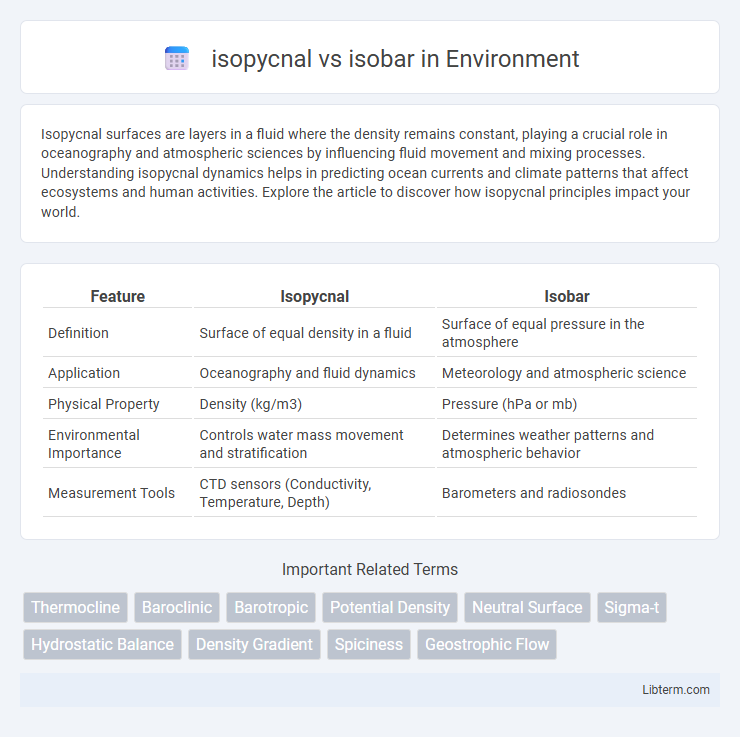Isopycnal surfaces are layers in a fluid where the density remains constant, playing a crucial role in oceanography and atmospheric sciences by influencing fluid movement and mixing processes. Understanding isopycnal dynamics helps in predicting ocean currents and climate patterns that affect ecosystems and human activities. Explore the article to discover how isopycnal principles impact your world.
Table of Comparison
| Feature | Isopycnal | Isobar |
|---|---|---|
| Definition | Surface of equal density in a fluid | Surface of equal pressure in the atmosphere |
| Application | Oceanography and fluid dynamics | Meteorology and atmospheric science |
| Physical Property | Density (kg/m3) | Pressure (hPa or mb) |
| Environmental Importance | Controls water mass movement and stratification | Determines weather patterns and atmospheric behavior |
| Measurement Tools | CTD sensors (Conductivity, Temperature, Depth) | Barometers and radiosondes |
Introduction to Isopycnal and Isobar Concepts
Isopycnals are lines on a graph or map that connect points of equal density within a fluid, often used in oceanography and atmospheric sciences to analyze water or air mass distribution. Isobars refer to lines connecting points with equal atmospheric pressure, commonly applied in meteorology to interpret weather patterns and pressure systems. Understanding isopycnal and isobar concepts is essential for analyzing fluid dynamics and atmospheric behavior, with isopycnals highlighting density variations and isobars illustrating pressure changes.
Defining Isopycnal: Meaning and Importance
Isopycnal surfaces represent layers in a fluid where the density remains constant, playing a crucial role in oceanography and atmospheric sciences by helping to track water masses or air parcels without density changes. These surfaces contrast with isobars, which connect points of equal pressure and are fundamental in weather forecasting and pressure system analysis. Understanding isopycnal surfaces enhances predictions of fluid mixing, stratification, and buoyancy-driven flows, essential for climate models and environmental studies.
Understanding Isobar: Key Principles
Isobars are lines on a weather map connecting points of equal atmospheric pressure, crucial for interpreting weather patterns and forecasting. Understanding key principles involves recognizing that tightly packed isobars indicate strong winds due to steep pressure gradients, while widely spaced isobars suggest calmer conditions. Accurate analysis of isobaric patterns helps meteorologists predict storm systems, wind direction, and intensity effectively.
Isopycnal Surfaces in Oceanography
Isopycnal surfaces in oceanography represent layers of constant density within the ocean, crucial for understanding water mass distribution and ocean circulation. These surfaces guide the flow of water along paths of equal density, minimizing vertical mixing and allowing for the study of nutrient transport and heat exchange. Contrasting with isobar surfaces that indicate constant pressure, isopycnal layers better capture the stratification and dynamic behavior of the ocean's interior.
Isobar Surfaces in Meteorology
Isobar surfaces in meteorology represent areas of equal atmospheric pressure, essential for analyzing weather patterns and predicting storm systems. These surfaces are typically mapped at constant pressure levels, helping meteorologists understand wind flow and pressure gradients. Unlike isopycnal surfaces that follow constant density, isobar surfaces allow for the examination of pressure-driven atmospheric dynamics critical for weather forecasting.
Differences Between Isopycnal and Isobar
Isopycnals represent lines of constant density in a fluid, whereas isobars are lines of constant pressure. Isopycnal surfaces are crucial in oceanography and atmospheric science for understanding stratification and fluid flow driven by density variations. In contrast, isobars are primarily used in meteorology to analyze pressure systems and predict weather patterns, reflecting pressure gradients rather than density differences.
Applications of Isopycnal Analysis
Isopycnal analysis, which examines surfaces of equal density, is essential in oceanography for understanding water mass distribution, mixing processes, and tracer transport in the ocean interior. Unlike isobaric surfaces that represent constant pressure, isopycnal surfaces better align with natural ocean stratification, enabling more accurate modeling of ocean circulation and nutrient dynamics. This approach improves climate models and aids in predicting biogeochemical changes by capturing the movement of water masses along density layers.
Uses of Isobar Analysis in Weather Forecasting
Isobar analysis plays a critical role in weather forecasting by helping meteorologists identify high and low-pressure systems, which influence wind patterns and storm development. By mapping isobars on weather charts, forecasters can determine pressure gradients that indicate wind speed and direction, essential for predicting weather changes. Isopycnals, which connect points of equal density, are primarily used in oceanography to study water column stability and stratification, making them less relevant for atmospheric weather predictions.
Isopycnal vs Isobar: Visualization and Mapping
Isopycnal and isobar lines represent different physical properties on maps, with isopycnals indicating locations of equal density and isobars showing areas of equal atmospheric pressure. Visualization of isopycnals is crucial in oceanography for understanding water column structures and density-driven ocean currents, while isobars are fundamental in meteorology for analyzing pressure systems and predicting weather patterns. Mapping these lines requires distinct data sources; isopycnal charts rely on salinity and temperature profiles, whereas isobar maps use barometric pressure readings from weather stations or satellites.
Conclusion: Comparing Isopycnal and Isobar Significance
Isopycnals represent surfaces of equal density critical for understanding ocean stratification and mixing processes, while isobars indicate surfaces of equal atmospheric pressure essential for weather forecasting and wind pattern analysis. The significance of isopycnals lies in their role in tracing water mass movements and thermohaline circulation, whereas isobars are fundamental for predicting high and low-pressure systems that drive meteorological phenomena. Comparing both reveals that isopycnals are crucial in oceanography for density-driven flows, whereas isobars dominate atmospheric science by mapping pressure gradients influencing weather dynamics.
isopycnal Infographic

 libterm.com
libterm.com